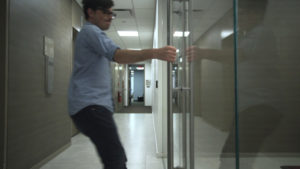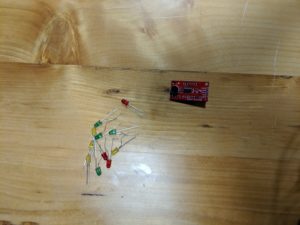This week’s project was to make something using an analog sensor to make an unexpected result. So i basically made a game where you have to turn the buzzer on. I will not include the code, because it can have the answers to how to turn the buzzer on. I use a potentiometer and a light sensor (a.k.a. light resistor). Nothing more to add, everything else you’ll see at the class presentation.
Month: February 2019
Intruder Detector
For this project, I was especially interested in using a light sensitive resistor as well as the force sensor we briefly discussed during class on Wednesday. My initial thoughts about analog inputs was that they would be extremely useful in detecting changes in the environment around the device, and how they could be used to manipulate outputs once they reached a certain value, or decreased to a certain value. Specifically I thought about how this could be used in a context of a home, how things could be activated without having to flip a switch, but by less explicit actions that would make things much more convenient.
For this assignment, I decided to create an Intruder Detector that would detect changes in light in my model home’s doorway as well as a force sensor discreetly placed below the window of the home. I also decided to incorporate LEDs as well as a piezo buzzer to create different patterns and reactions depending on what was happening in the model home. I soldered the components (except for the buzzer and the force sensor) and taped them onto the house.
Below is a schematic of my model home and how it would be configured with the Arduino
By default, the room of the house is set on “tranquil” mode, and the blue LED is turned on while the piezo buzzer remains on silent and the two red LEDs remain off. If the value of the photoresistor decreases below 440, the alarm goes off and the red light on the floor flashes, indicating that a shadow has passed through the doorway. If the value of the force sensor goes over 60, the red light on the wall turns on. However, the buzzer does not go off until the value of the force is at 500, because the owner’s cat weighs a little less than 500, and any value above that would be a bigger object (a burglar!). If the force value is greater than 500 and the photoresistor is less that 440, this indicates that a gang of burglars has laid siege to the house through the two entrances! The buzzer emits a high pitch noise and the two lights flash rapidly.
const int blueLed = 2;
const int forceLed = 3;
const int lightLed = 4;
const int piezoPin = 5;
int forceVal = 0;
int lightVal = 0;
int forceLight = 0;
int lightLight = 0;
void setup() {
// put your setup code here, to run once:
Serial.begin(9600);
pinMode(blueLed, OUTPUT);
pinMode(forceLed, OUTPUT);
pinMode(lightLed, OUTPUT);
}
void loop() {
// put your main code here, to run repeatedly:
forceVal = analogRead(A1); // read the input pin
lightVal = analogRead(A0); // read the input pin
if (lightVal < 440) {
analogWrite(lightLed, lightVal);
digitalWrite(blueLed, false);
Serial.println(lightVal);
tone(piezoPin, 1000, 500);
}
if (forceVal > 60) {
digitalWrite(forceLed, true);
digitalWrite(lightLed, false);
digitalWrite(blueLed, false);
if (forceVal > 500) {
tone(piezoPin, 100);
digitalWrite(forceLed, true);
}
else {
noTone(piezoPin);
digitalWrite(forceLed, true);
}
}
if (forceVal > 500 && lightVal < 440) {
analogWrite(lightLed, lightVal);
digitalWrite(forceLed, true);
tone(piezoPin, 5000, 500);
delay(150);
digitalWrite(lightLed, false);
digitalWrite(forceLed, false);
tone(piezoPin, 100, 500);
delay(150);
analogWrite(lightLed, lightVal);
digitalWrite(forceLed, true);
tone(piezoPin, 5000, 500);
Serial.println(forceVal);
}
if (forceVal < 10 && lightVal > 440) {
digitalWrite(blueLed, true);
digitalWrite(lightLed, false);
digitalWrite(forceLed, false);
}
}
Response to Norman
Reading Norman’s chapter “The Psychopathology of Everyday Things” feels like finally revealing the obvious. He clearly identifies and points at something that you had right in front of your eyes the whole time, but never really thought of.
Although I have a feeling that Crawford’s definition of interaction would not succeed with most of the cases that Norman brings up as highly interactive, Norman adds another layer to all of it- and that is the triangle between the designer, product and user. While it is not a direct interaction, it is a form of communication, which is crucial to be understood in order to create a successful design. I am still a bit conflicted about the importance of the categorization and use of specific terms in such a rigid way, yet I still agree with most of both Crawford’s and Norman’s works that critically and academically contribute to such an underrepresented and underestimated field of study.
However, I would strongly disagree with his statement that good design is pleasurable. Usually, when a design works properly, it goes indifferently unnoticed, taken for granted. One would beg to differ that since we are used to bad designs, we would be pleasantly surprised when we encounter a good one and consequently appreciate it. Yet, at least from my experience, I rarely hear someone appreciating something as a well-designed sink stopper. What, on the other hand, I keep hearing constantly, is the irritated complaints about things like bad signaling on doors or badly designed fridge temperature regulators. I would therefore argue that designers should not strive to make the experience pleasurable, as Norman suggests, but most importantly natural, make it feel the way it could not have been designed any other way- as if even no design was needed whatsoever.
What I truly enjoyed reading about is the feedback part about design. However, I would extend the idea not only to product-user interaction, but the more difficult one: designer-user one. Although in today’s world, the wall that prevented designers and users to communicate is becoming thinner and thinner with review websites and pretty much any means of communication. But does it work fast enough and are the users responsive enough? Let’s say that the refrigerator controls were designed very badly and annoy us quite a bit, but not too much. How many of us would actually bother to email the company with feedback? Since designs mostly get replicated and extended – not designed completely from scratch, this is how we end up in a world full of things that have a potential to function well, but do not.
Lastly, the cultural implication is brought up by Norman to signify, how good design is difficult, if not impossible, to create because “natural” means something else in different contexts. For me, the horrible sink stopper design he was talking about, would be a completely natural design that I pretty much grew up with. This is a problem arising with a more globalized market and that sets designers for an impossible task to satisfy everyone- alongside the manufacturers, the purchasers, the sellers and the repair services- and in any cultural context. All of this makes the job extremely difficult, yet even more pressing to give recognition and gratitude to.
I will just end with a reference for an artist that challenges the designs that we take for granted. 
The Uncomfortable by Katerina Kamprani. Source: theuncomfortable.com
Response to Reading #2
In this reading, the author talks about multiple concepts of design. What is good design? Is it to make things more functional and efficient or beautiful with little/ minimal regard to function?
When designing appliances that are sophisticated and complex, we have to work on making them easy to operate, or else the design would’ve lost its value. The reading made me think about how technology and devices are most often than not designed to look pleasing rather than to maximize their function. What is the point of making something beautiful if it’s not going to be used to its full potential?
In the reading there was a mention of devices being the problem and not humans, this reminded me of a sewing machine I got for my 15th birthday. It was described to be a perfect siege into the world of sewing- and yet, I don’t think I’ve ever used it more than three times due to how confusing it was to operate. How can we make devices like the sewing machine easy to use, how can we design them so someone who doesn’t have experience won’t need to scavenge for a YouTube video to do the simplest of things when it comes to that particular device? 
Response: The Psychopathology of Everyday Things
The first reaction I had was a laugh. When I looked at the teapot, and finally realized the joke, I had a grin on my face. What made the beginning more funny was that the “Norman door” thing was actually real, and the doors that bug me every day are actually named after Norman.
One example that reminded me was a flashlight I had back when I was in China. It was very simple, yet as a kid I spent hours and hours to figure out how to turn it on. Since I was so accustomed to thinking that flashlights always had a switch, usually buttons, I was analyzing the object so meticulously that I was almost about to dismember the whole thing. When I almost gave up, I rotated the bottom part of the flashlight (like how you rotate the cap of a water bottle) and it worked! The creative yet unpopular design of the flashlight reminded me of a similar object with low discoverabilility.
One question (and a thought) however, that came to mind while reading this was that I do agree generally that most machines and products that we utilize should have great discoverability and understanding, we should not generalize this and state the ALL products should do so. This is because some are intended for us to question its usage and that curiosity is what makes the product sell. For instance, when I first came to the old market near WTC mall, I bought a wooden box that seemed normal, but had a secret pocket inside to hide my most precious goods. Had most people known this, I am sure that the functionality of the object would have decreased immensely into the state of just being a wooden box with extra slots.
As I scrolled through the photos at the end, another funny example occurred, as I was able to relate to the author. He was in a London hotel where the sink was supposed to be pushed instead of draining automatically or with a lid to cover. That way, the sink was like a switch; once pushed, it would not drain the water, which confused the author as he was accustomed to other designs of sinks. I too had the same problem when I first faced bathroom sinks here at NYUAD, which is why when I saw his example I started laughing as well.
All in all, this was a very enjoyable text for me to read, and really had me thinking again about new categories to define how “good” or how “bad” products are really are, in this case their aim for consumers and how they are designed for these people to use them.
Reading Response – The Design of Everything
The Design of Everyday Things
The Psychopathology of Everyday Things (Chapter 1)
Don Norman
As an individual who views design as a critical part of developing a digital product, I agreed with many parts of Norman’s writing. Indulging in both the front-end area of web development and the logical parts of computer science, I understand the common quarrel between engineers and designers that Norman mentioned in the early parts of the chapter. For instance, Norman’s analogy of engineers and designers reminded me of my experience in working with both developers and designers for building a website. For the most part, the designers would want a certain outlook of the website that they created in regards to the user’s expectations. They would create personas to show the prediction of different interactions and use them to support their designs. On the other hand, the developers will only comment on the practicality or eligibility in putting the design into code – if certain parts are redundant or practically impossible, the developers will not accept the design. Then, the whole arguments falls into a repeated loop.
Moreover, nowadays we see a lot of machines that has no considerations for the users. One example would be an android phone. As someone who has used both an iPhone and an android phone, I felt that the android phones have countless functionalities that are not only hard to use, but also too complicated. A typical Samsung phone would have more than 10 variation of finger motions that were rather discomforting to use and 15 pre-installed applications that I did not know what they were for. When used correctly, these features can be of great use, but they are just futile affordances without the necessary signifiers.
So, I believe that the human-centered design is a crucial aspect when it comes to any products that we use. If the products were designed based on “the needs, capabilities, and behavior” (Norman, 7) of the users, it will be easier to predict how the users will interact with the product, detect any problems beforehand, and make the overall interaction gratifying. One of the examples I have found was the use of personas. Personas are hypothetical users based on a user type, and personas are used in order to identify the possible user experience scenarios. By using personas, we can design the product centered to the users according to their needs and predicted problems and making”the collaboration of person and the device feel wonderful” (Norman, 7).
Response: The Psychopathology of Everyday Things
I found that the author of this reading was able to put into very concise and understandable terms the importance of design and some key concepts that define the field. I find that this was able to provide me with a thorough overview of what designers must take into account when designing new products or experiences.
I find it very fascinating how he argues that despite engineers or developers’ thorough understanding of the product they are creating, they are not able to understand the complex emotions and behavior of people that use their product. I am curious how companies might find a perfect middle ground where their designers understand both the complex technology that they are designing, as well as the behaviour of people who use it.
I also found his discussion of feedback very interesting and thorough, as this is something that I often encounter when using products. I find that numbers and labels are arbitrarily placed and assigned on a product or interface, and not only that, there is no way to determine whether or not what you are doing is correct or nor until it is often too late. These are things I have considered, but Norman put it in simple yet effective terms that allow me to think about design in the things I interact with.
Response: The Psychopathology of Everyday Things
I really liked Norman’s method of breaking down design in terms of terminology used and the many different conceptions that are integrated within it.
Bad design is definitely a hassle that almost everyone has faced at one point in their life or another. However, while reading his work at first, I felt as if Norman was being a little bit exaggerated about how important design and signifiers are in daily life and objects but then I remembered being in London a few weeks ago and struggling to work the tap for a good ten minutes before asking for help (my roommates did not know either). The situation we faced was pretty disruptive and frustrating and a set of clearer indications on the tap could have definitely averted this problem; thus, I conceded that Norman is correct in identifying how crucial design is for objects – especially those that should not require too much thinking in the first place.
“The same technology that simplifies life by providing more functions in each device also complicates life by making the device harder to learn, harder to use. This is the paradox of technology and the challenge for the designer.”
Moreover, Norman’s statements about the future of design really resonated with me as well. Watching my grandmother or even my mom interact with a new phone is painful at best as they attempt to understand how each flick of their finger or movement of their face will cause a change on the screen. Even myself, having access to iPhones, Macs etc. am unable to remember sometimes how different movements can result in different results without having to look them up. Even as I write this, having become used to using a Windows computer in my class and changing back to a Mac for personal work, I continue to mistake the commands on the keyboard between the two. This makes me question, what does this mean for the future of design as electronics get more and more complicated in terms of functionality?
Response: “The Psychopathology of Everyday Things”
Before reading this chapter, I had no idea that my inability to open certain doors would be addressed as a bad design concept. I’ve noticed that I’ve walked into numerous doors only to take a step back to understand how exactly to open it. Once I genuinely thought I was locked inside the NYU Shanghai staircase because the door handle was locked when I tried to twist and pull. I had to text my friend to get me out of the staircase and when she came she told me to just push. Thanks for letting me know that my stupidity was because of bad designers, Norman!
I found the concept of discoverability very familiar. To me, it sounded like what we read about interaction. How is the agent interacting with the object. What is the relationship between these two items? The only difference to me seemed to be the fact that affordance needs to be useful. These affordances will determine what actions are possible. Norman then goes and talks about how signifiers are used to communicate where action should take place and that we need both affordance and signifiers. However, he also talks about how adding external signifiers that need to be added indicate bad design. I totally agree on the last point, but I wonder what the line is between when there is too much signifiers and when signifiers aren’t needed at all. I would think that it is very similar to when feedbacks are considered to be too much to point where it starts to annoy people.
Another point Norman made was about how engineers are bad designers because they think too logically, and not everyone can follow and interact with the product the way engineers want them to. I think this is where designers come in, but there is still a problem between what the designer want users to do vs what the user actually ends up doing with the product. There is still the burden of communication and I’m not sure where Norman would suggest to fix this problem. User testing? After all of Norman’s examples, it still amazes me how designers/companies still roll out with products like digital watches with buttons that aren’t labeled.
Noise Meter
My mother will hate me for this, but I have to say it: I come from a loud house. So it only makes sense to let myself know how loud since I would be drowning in noise anyway. I used the following code to connect a sound sensor to a series of LEDs that light up in sequence the louder the sound. In started with three, and then distributed the hertz across 9 LEDs after I solidified my logic.
int soundSensor = A0; // select the input pin for the soundSensor
const int ledPinR3 = 13; // select the pin for the LED
const int ledPinR2 = 12;
const int ledPinR1 = 11;
const int ledPinY3 = 10;
const int ledPinY2 = 9;
const int ledPinY1 = 8;
const int ledPinG3 = 7;
const int ledPinG2 = 6;
const int ledPinG1 = 5;
void setup() {
// put your setup code here, to run once:
//declare the sounSensor as INPUT
pinMode(soundSensor, INPUT);
pinMode(ledPinR1, OUTPUT);
pinMode(ledPinR2, OUTPUT);
pinMode(ledPinR3, OUTPUT);
pinMode(ledPinY1, OUTPUT);
pinMode(ledPinY2, OUTPUT);
pinMode(ledPinY3, OUTPUT);
pinMode(ledPinG1, OUTPUT);
pinMode(ledPinG2, OUTPUT);
pinMode(ledPinG3, OUTPUT);
Serial.begin (9600);
}
void loop() {
// put your main code here, to run repeatedly:
//create an integer to sense the data from the sensor. it is an analog one, so you have to analogRead.
int soundValue = analogRead (soundSensor);
Serial.println(soundValue);
if (soundValue >= 21)
{
digitalWrite (ledPinG1, HIGH);
} else {
digitalWrite (ledPinG1, LOW);
}
if (soundValue >= 70)
{
digitalWrite (ledPinG2, HIGH);
} else {
digitalWrite (ledPinG2, LOW);
}
if (soundValue >= 150)
{
digitalWrite (ledPinG3, HIGH);
} else {
digitalWrite (ledPinG3, LOW);
}
if (soundValue >= 170)
{
digitalWrite (ledPinY1, HIGH);
} else {
digitalWrite (ledPinY1, LOW);
}
if (soundValue >= 210)
{
digitalWrite (ledPinY2, HIGH);
} else {
digitalWrite (ledPinY2, LOW);
}
if (soundValue >= 250)
{
digitalWrite (ledPinY3, HIGH);
} else {
digitalWrite (ledPinY3, LOW);
}
if (soundValue >= 280)
{
digitalWrite (ledPinR1, HIGH);
} else {
digitalWrite (ledPinR1, LOW);
}
if (soundValue >= 310)
{
digitalWrite (ledPinR2, HIGH);
} else {
digitalWrite (ledPinR2, LOW);
}
if (soundValue >= 350)
{
digitalWrite (ledPinR3, HIGH);
} else {
digitalWrite (ledPinR3, LOW);
}
}
We also read some foundational texts regarding design.
Reading Don Norman’s work on affordances and human centered design ironically made me worry about the future of the field. As someone deeply in love with design, Norman’s exceptional ideas about how to design our world expressed, at first, an end to the practice. An exhibit in London described a compelling idea along these lines: that humans are regularly creating a world that no longer requires humans. In the same way, are designers creating a world that no longer requires designers?
Although the thought sparked some initial anxiety, a few ideas in Norman’s text provided some comfort. He expresses that technology and people are constantly evolving and changing. As technology improves, as human behavior changes, the nature of affordances change. What we need as a society change. He also describes, when discussing mapping, that culture can define certain design ideas, and that although some concepts should be universal, others work best for particular societies.
Here, we reach the notion of the zeitgeist, and how we impact it as designers. If culture is constantly shifting and created by us, then maybe the norms of how we view chairs and what they are used for will also change. Changed by our own will. As someone who hopes to enter this design world, I can both be comforted in not only that design will exist and be necessary for as long as I am alive, but also that it will exist and be necessary for as long as humans are alive.



